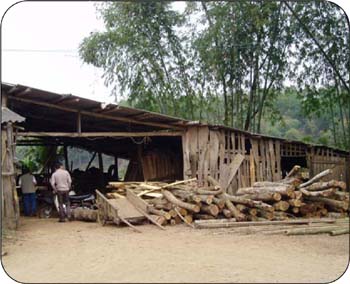Industrial timber production will continue to be a primary objective for many reforestation projects, including using fast-growing, exotic species to grow pulpwood on short rotations.
However, it seems likely that some different forms of reforestation will also be needed in the future. It is clear there is a wider range of stakeholders who are interested in the potential benefits of tree planting beyond just the industrial wood uses that have dominated in the past (ITTO 2002).
These stakeholders might include farmers and rural communities, water managers and hydroelectric power generating agencies as well as protected area managers. That is, large commercial timber companies will not be the only organizations interested.

Small rural sawmills... a crucial market for many of the timber produced by farm or community forestry.
Consequently, these future plantations might be expected to provide functional benefits and ecological services as well as "goods" and will include reforms of reforestation that might be covered by the terms "rehabilitation" or even "restoration" (see Box 1). That is, they will provide:
higher quality timbers that are able to attract higher market prices;
clean water;
improved soil fertility on the increasing number of sites now degraded by previous land uses;
multiple forest products from mixing timber trees with plants producing non-timber forest products such as medicinal plants; and
carbon sequestration.
In some special cases, the specific objective of reforestation will also be the re-establishment of forests resembling those originally present at the site to restore at least some of the original wildlife habitats and biological diversity (Elliott et al. 2000).
Even where this is not the primary objective, biodiversity conservation is likely to become a more significant component of many plantation programmes in the future because forest plantations will be one of the few areas where landscape rehabilitation can be achieved.
|
New forms of reforestation will require different types of silvicultural knowledge |
These plantations will therefore include:
management encompassing long rotations as well as short rotations;
those suitable for small (farmer) woodlots as well as large industrial plantations; and
those managed as protection forests and nature reserves as well as those managed largely for timber production.
These new forms of reforestation will require different types of silvicultural knowledge. For example, they will require knowledge of:
The silviculture of a wider range of species than has been the case before. These will include high-value timber trees (that may grow more slowly in volume than the exotic fast-growing species, but which will have a higher value increment), as well as species that are able to grow at degraded sites (many of which will necessarily be exotic species).
The impacts of reforestation on local and regional hydrology; many policy makers expect reforestation will make streams run again and increase water supplies. In fact, young plantations will reduce water supplies from reforested catchments.
Species-site relationships to ensure the most appropriate species are used at particular sites.
Ways of restoring biodiversity (animals as well as plants) and ecological complexity to sites.
The silviculture and horticulture techniques for developing short-term crops (e.g. agricultural crops and medicinal plants) beneath the tree canopies.
|
Box 5. Dealing with changed or unexpected circumstances Tree plantations lose out to annual crops because of lengthy growth periods and because circumstances can change during a rotation cycle. Or sometimes problems only emerge after a considerable time has passed. Examples include: · Vernicia montana is an oil-producing tree that was established over large areas (around 20 000 ha) in Viet Nam to supply a market in China. The oil has been used for paints, plastics and medicines. But in recent years, the market has changed and the plantations have become valueless because the market for V. montana oil has fallen. This illustrates the dangers of relying on a single market. · Cinnamomum cassia has been widely planted in Viet Nam to produce highly valued oil. The oil is extracted from bark and has been used for medicines, foods and cosmetics. But the oil content in the plantation trees can vary with the seed source used, and can also be low if planted on unsuitable sites. Good tree growth is not always accompanied by high oil content. This illustrates the need to undertake trial plantings and quality testing before embarking on large-scale establishment programmes. Quality testing may only be possible some years after trees are established. · Jackfruit (Artocarpus spp.) is known to grow well in home gardens. However, the species does not grow nearly as well in larger plantations. The reasons for this are unclear. Nutrition may be a factor in some situations but is not the sole cause. Again, this illustrates the need for prior testing before embarking on large plantation schemes. These examples illustrate that planting single-purpose tree crops for a single market is risky. The risks can be economic as well as biological and may not emerge for some time. Such risks may be acceptable for a government agency or large corporation to take, but they are risks a smaller grower would be unwise to accept. |
Finally, changes in the ways reforestation is carried out are only likely to be possible if plantations are designed to include a higher degree of silvicultural flexibility to deal with the fact that markets for goods and services can change over the time of a rotation.
This is particularly the case with reforested areas near large population centers. Examples of problems arising from a lack of flexibility are given in Box 5 below.